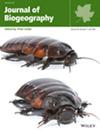Geomorphological River Characteristics Explain Species Turnover in Amphibians, Reptiles and Lemurs in Madagascar's Eastern Rainforests
Abstract
Aim
The riverine barrier hypothesis is often tested as a driver for allopatric speciation. Rivers are usually treated as static landscape features characterised by their width and elevation of their headwaters. We aim to investigate the role of rivers as barriers using a comprehensive database of geomorphological characteristics by assessing their influence on species turnover rates.
Location
Eastern Madagascar.
Taxon
Sixty-two taxa from 11 genera of lemurs, amphibians and reptiles.
Methods
We compiled 21 geomorphological variables for 45 major rivers, estimated species turnover rates from species assemblages on either side and modelled the influence of river characteristics on species diversity. Topographic depressions, identified from longitudinal river profiles, and landscape heterogeneity were further analysed as potential palaeoclimatic refugia and alternative speciation drivers.
Results
A total of 24 rivers acted as species barriers. Three of these had disproportionately high species turnover rates and shared a set of distinct geomorphological features like the maximum elevation of the watershed, high flow accumulation values at the outlet and at an elevation of 800 m and a high concavity of the longitudinal river profile. Other variables like landscape heterogeneity along the main river channel and length of the coastal plain further helped to differentiate between rivers with intermediate turnover rates. Species richness peaked in northeastern Madagascar, a region with the highest abundance of topographic depressions and inferred palaeo-wetlands.
Main Conclusions
Geomorphological river characteristics effectively explained variations in species turnover rates. However, it remains uncertain whether rivers functioned as secondary dispersal barriers and thereby maintainers of species diversity, rather than as primary drivers of allopatric speciation. Additionally, we emphasise the role of refugia during palaeoclimatic oscillations, which are often associated with topographic depressions. Overall, integrating rivers as dynamic fluvial systems through space and time into biogeographic studies offers valuable insights into speciation, dispersal and the persistence of taxa.


 求助内容:
求助内容: 应助结果提醒方式:
应助结果提醒方式:


